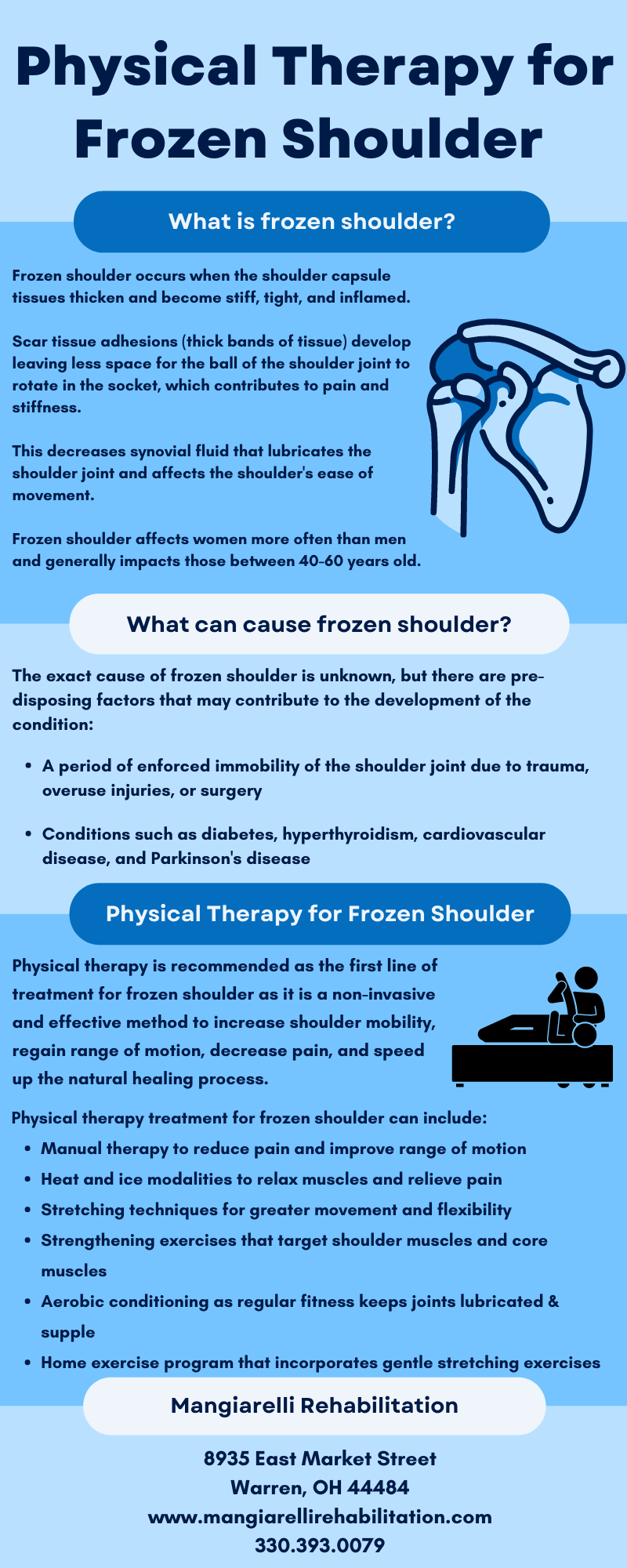Frozen Shoulder Infographic
Frozen shoulder is a condition that causes pain and stiffness in the shoulder joint and can significantly reduce shoulder mobility. Frozen shoulder occurs when the shoulder capsule tissues thicken and become stiff, tight, and inflamed. Scar tissue adhesions (thick bands of tissue) develop, leaving less space for the ball of the shoulder joint to rotate in the socket. A decrease in synovial fluid, which lubricates the shoulder joint, also occurs which affects the shoulder’s ease of movement.
The exact cause of frozen shoulder is unknown, but there are predisposing factors that can contribute to the development of the condition. Frozen shoulder can develop suddenly or gradually when recovering from a medical condition or surgery that requires a period of enforced immobility of the shoulder, due to a trauma to the joint, or due to joint inflammation from tendonitis, bursitis, or rotator cuff injury.
Health conditions like diabetes, hyperthyroidism, cardiovascular disease, and Parkinson’s disease can also predispose you to develop frozen shoulder. With a frozen shoulder, it is common to experience pain when moving or rotating the shoulder, stiffness that prevents you from moving the shoulder, and increased pain at night.
There are three stages of frozen shoulder:
Freezing Stage: This early stage is the most painful in which the individual experiences extreme shoulder pain with movement, an onset of stiffness in the shoulder joint, muscles spasms, and symptoms that worsen at night. This stage can last between 3 to 9 months. The shoulder isn’t fully frozen yet but is starting to freeze and solidify.
Frozen Stage: During this adhesive stage, the shoulder experiences the most stiffness, and the main characteristic of this stage is the inability to move the shoulder. Pain begins to subside in the latter portion of this stage. This stage can last 9-15 months. Physical therapy is particularly helpful during this stage to improve the range of motion in the frozen shoulder, begin to regain mobility, and speed up the healing and “thawing” process.
Thawing stage: This recovery stage involves a gradual decrease in stiffness and pain and a return to shoulder range motion as the shoulder “thaws.” This stage can last 15-24 months. Physical therapy is critical during this stage to regain full range of motion, strength, mobility, and function in the shoulder.
Physical therapy is recommended as the first line of treatment for frozen shoulder as physical therapy is a non-invasive yet effective method to increase shoulder mobility, regain range of motion, decrease pain, and speed up the natural healing process.
Physical therapy treatment for frozen shoulder can involve:
Manual therapy soft tissue and joint mobilizations of the shoulder to reduce pain and gently improve range of motion
Heat and ice modalities to relax muscles and relieve pain
Stretching techniques for greater movement and flexibility
Strengthening exercises that target shoulder muscles and core muscles
Aerobic conditioning as regular fitness helps keep your joints lubricated and supple
Home exercise program that incorporates gentle stretching exercises
If you are experiencing a frozen shoulder or growing shoulder pain and stiffness, don’t suffer in silence. Start your journey to regaining shoulder strength, mobility, and function today with our physical therapists!

